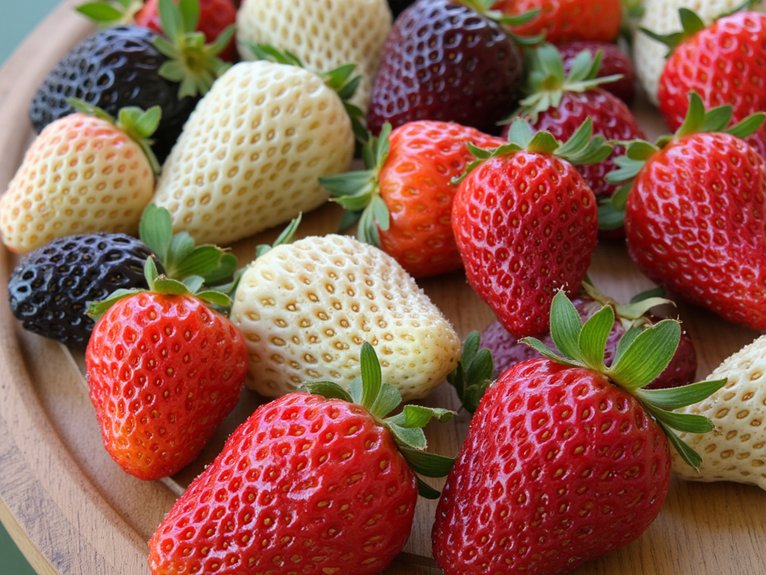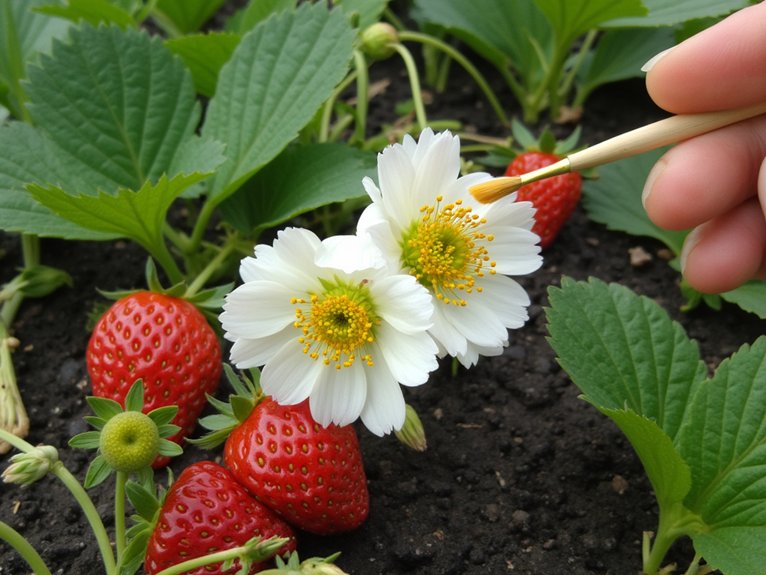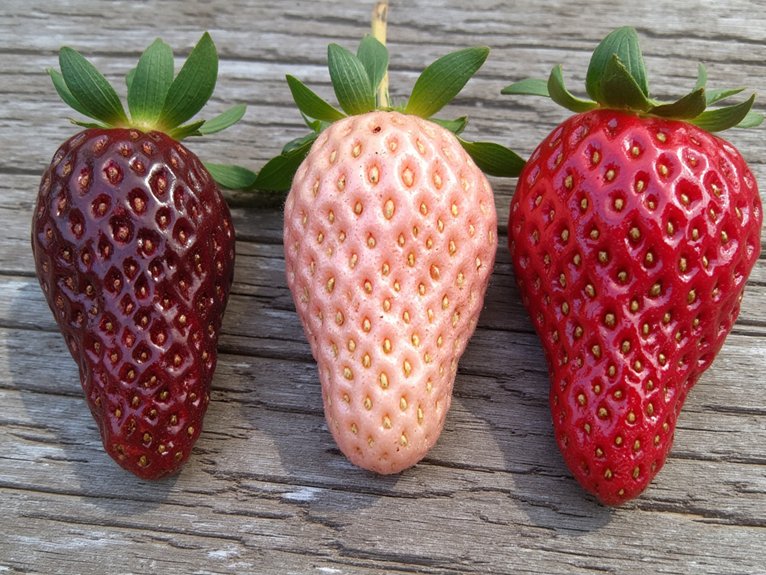Gardeners seeking to expand beyond common red strawberries can explore a spectrum of naturally vibrant varieties. From pure white Pineberries with tropical hints to golden Yellow Wonder berries offering citrus notes, these alternative cultivars bring unexpected colors and flavors to home gardens. “These unique varieties often contain higher antioxidant levels than traditional red strawberries,” notes Dr. Sarah Chen, plant geneticist at Cornell University. The journey into colorful strawberry cultivation begins with understanding their distinct growing requirements.
Contents
The Rainbow World of Strawberry Varieties

A kaleidoscope of strawberry colors exists beyond the familiar red varieties found in grocery stores. From the creamy whites of Alpine berries to the deep burgundy of Purple Wonder, these unique varieties offer striking colors and unexpected flavor profiles.
White Pineberries display red seeds against pale flesh, while Yellow Wonder produces golden fruits with tropical notes. The Purple Wonder, developed by Cornell University, transforms from white to burgundy as it ripens. These varieties, created through traditional breeding rather than genetic modification, allow home gardeners to explore nature’s diversity through carefully cultivated plants that bring both beauty and distinctive tastes to the garden.
Natural Colors Beyond Traditional Red
While most people picture bright red strawberries dotting their garden beds, nature offers an impressive spectrum of colors in these beloved fruits. From creamy white Alpine varieties to deep purple ‘Purple Wonder’ and golden-yellow treasures, these natural variations bring both visual interest and unique strawberry flavors to the garden.
The color significance extends beyond aesthetics – white strawberries often carry tropical notes of pineapple and coconut, while darker varieties typically pack more antioxidants. Burgundy-hued ‘Musk’ strawberries deliver complex wine-like undertones, and pineberries showcase striking white flesh dotted with red seeds, offering a distinctive pineapple essence that surprises the taste buds.
How Plant Breeders Create Unique Strawberries

Plant breeders develop unique strawberry varieties through careful selective breeding programs that can span more than a decade. Using hybridization techniques, they cross-pollinate plants with desired traits like unusual colors or enhanced flavors.
The process mimics Mendel’s famous pea plant experiments, requiring multiple generations of plants to stabilize new characteristics. Cornell University’s ‘Purple Wonder’ strawberry, for example, took 13 years of selective breeding to perfect.
Breeders focus on naturally occurring mutations and wild varieties, avoiding GMO methods. They collect seeds from plants displaying unique colors or flavors, then gradually refine these traits through repeated growing cycles until achieving consistent results.
Popular White and Yellow Strawberry Types
White and yellow strawberry varieties have captivated gardeners with their unusual colors and distinctive tropical flavor profiles. The ‘White Soul Alpine’ and ‘White Pineberry’ offer creamy-colored fruits with hints of pineapple and coconut, while ‘White Alpine’ traces its heritage back 300 years.
For yellow strawberries, the ‘Yellow Wonder’ produces golden fruits that Europeans often prefer over traditional red varieties. These berries take 120 days from seed to harvest, offering a unique tropical taste. The ‘Golden Alexandria’ variety yields thimble-sized fruits on compact plants, making it ideal for container gardens.
Purple and Pink Varieties to Try

Among the most striking strawberry varieties available to home gardeners are those in purple and pink hues. The ‘Purple Wonder’ cultivar, with its deep burgundy undertones, offers both visual appeal and intense flavor. Its compact growth makes it ideal for container gardens.
For pink enthusiasts, the ‘Tristan’ variety delivers both purple passion in its foliage and pink delight through its vibrant fuchsia flowers. This everbearing plant produces sweet, elongated berries throughout the growing season.
Both varieties thrive in full sun and well-draining soil, requiring consistent moisture and spacing of 12 inches between plants for peak growth.
Growing Tips for Novelty Strawberries
While novelty strawberries offer exciting possibilities for home gardens, successful cultivation requires attention to specific growing conditions and maintenance practices. Basic strawberry care begins with selecting a location that receives 6-8 hours of direct sunlight daily.
For ideal planting techniques, gardeners should:
- Space plants 12-18 inches apart
- Plant in well-draining soil with pH 5.5-6.8
- Water deeply but infrequently
- Apply mulch to retain moisture
- Remove runners regularly
- Fertilize monthly during growing season
“Proper spacing and soil preparation are essential for novelty varieties, which often have specific needs beyond traditional strawberries,” notes horticultural expert Dr. James Miller.
Where to Find Rare Strawberry Plants
Locating rare and unique strawberry varieties requires dedicated research beyond typical garden centers and big-box stores. Specialty nurseries often maintain collections of heirloom and unusual strawberry cultivars not found elsewhere.
Several reliable sources exist for obtaining rare strawberry plants:
- Specialty mail-order nurseries focusing on heritage fruits
- Online retailers specializing in unusual edible plants
- Local gardening clubs and plant exchanges
- University agricultural extension programs
- Small-scale organic farms
Many specialty nurseries ship bare-root plants during prime planting seasons, typically early spring or fall. For best results, order plants 2-3 months before the intended planting date to guarantee availability and proper timing.
